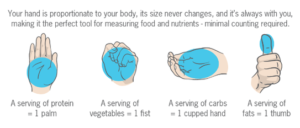Building your ‘perfect’ meal is as easy as using your own hand as a guide. No food scale necessary. With a bit of practice, you can learn to measure appropriate portion sizes by using your hand as a measuring tool, without the need to weigh and measure every single ounce or gram of food that passes your lips.
For many, weighing and measuring your food like you do with flexible eating/IIFYM/flexible dieting/counting macros/whatever you want to call it, can be… annoying. (I’m being blunt and completely transparent here.) It’s not for everyone, and that’s okay! The best diet for you to follow is the diet you want to successfully follow and one that you enjoy following. (Imagine that!)
Like anything, there are pros and cons to using your hand as a measurement and portion control tool.
The pros:
Your hand is portable and is with you everywhere you go.
Generally speaking, your hand is size-appropriate for your own body.
It’s simple!
The cons:
It’s not ‘exact.’ You could over- or under-eat by not weighing your food or counting calories (but there’s also negatives to counting calories or macros and weighing your food).
For meals with a LOT of ingredients, it can get overwhelming.
It can get messy if you don’t like licking your fingers. 😉
The best diet for you to follow is the diet you want to successfully follow and one that you enjoy following.
In today’s post, I’ll focus on the ways you can build your ideal meal using a method that’s simpler than in last week’s post that outlines the art of building a meal for the ‘flexible eating’ method.
STEP-BY-STEP MEAL BUILDING
Before you start, check-out this infographic from Precision Nutrition on how to use your hand to measure your portions — this is a thorough reference and it includes excellent visuals to help guide you along the way. Here, I’ll summarize many of the key points that Precision Nutrition’s experts make; these exact methods are the same successful methods my clients use when they don’t want to weigh and measure their food. You may find that using your hand as a measuring tool is also easier, like they did.
First, let’s cover the measurements:
Your palm is your protein portion.
Your closed fist is your vegetable portion.
Your cupped hand is your non-vegetable carbohydrate portion.
Your thumb is your fat portion.
Please note that a hand portion is the same shape as your palm/hand/thumb, so consider the thickness and diameter of the food as it compares to your hand.
This method assumes that you’ll be eating about three to four meals a day. Of course, this is dependent upon your activity level, hunger levels, and overall goals to consider.

Courtesy of Precision Nutrition
STEP 1: Select your protein of choice.
Proteins include meat, seafood, eggs, Greek yogurt, cottage cheese, and anything else that includes more protein than any other macronutrient (carbs and fat). Keep in mind that some meats and meat substitutes have more fat than other choices, so consider those fats as part of your fat intake for that meal.
A portion of protein is the size of your palm. A palm-size portion of protein is estimated to have about 20-30g of protein.
For men and/or individuals over 160-170 lbs more or less (this is just an estimate), start with two palm-sized portions of protein with each meal.
For women and/or individuals under 160-170 lbs more or less (again, this is an estimate), start with one palm-sized portion of protein with each meal.
STEP 2: Next, is your vegetable portion.
By “vegetables,” I mean broccoli, cauliflower, spinach, mixed greens salad, peppers, carrots, etc.
Vegetables not only help you consume more micronutrients (vitamins and minerals), but they also help increase your fiber intake, leaving you feeling fuller longer, as well as adding to the health of your overall digestion.
A vegetable portion is the size of your fist, which often has minimal amounts of carbs since vegetables are nutrient-dense and not calorie-dense.
For men, include two fist-sized portions of vegetables at each meal.
For women, include one fist-sized portion of vegetables with each meal.
STEP 3: Choose your non-vegetable carbohydrate.
These include foods like grains (such as rice), fruits, and starchy carbs (like potatoes).
A cupped handful-sized portion of carbs is estimated to have about 20-30g of carbs.
For men, include two cupped-handful portions with each meal.
For women, include one cupped-handful portion with each meal.
STEP 4: Choose your fat source.
Fats include oils, nut butters, nuts, seeds, butter, and countless other choices. Ideally, select a healthy fat such as avocado, nuts, or grass-fed butter.
Your thumb is a portion of fat. Each thumb is about 7-12g of fat.
For men, be sure to start with two thumb-sized portions of fats with each meal.
For women, have one thumb-sized portion of fat with each meal.
STEP 5: Season your food sparingly.
Seasoning your food makes it taste richer and more appealing, allowing you to adhere more closely to your nutrition plan.
TO SUMMARIZE
This method of portion control estimates about 2,300-3,000 calories per day for men and 1,200-2,100 calories per day for women, depending on how many portions and meals are eaten each day. This is only an estimation — but an estimation is better than not knowing how much you’re eating in a day.
While this isn’t a ‘perfect’ method, it at least gets you started in the right direction with planning your meals to include appropriate portions for your body size. Here’s a quick summary of the portions:
For men and/or individuals over 160-170 lbs more or less (again, this is an estimate):
- Two palm-sized portion of protein with each meal (so 6-8 portions a day)
- Two fists of vegetables with each meal (so 6-8 portions a day)
- Two cupped hands of non-vegetable carbs with each meal (so 6-8 portions a day)
- Two thumbs of fat with each meal (so 6-8 portions a day)
For women and/or individuals under 160-170 lbs more or less (again, this is an estimate):
- One palm-sized portion of protein with each meal (so 4-6 portions a day)
- One fist of vegetables with each meal (so 4-6 portions a day)
- One cupped hand of non-vegetable carbs with each meal (so 4-6 portions a day)
- One thumb of fat with each meal (so 4-6 portions a day)
Keep in mind that this is only a place to start to figure-out the appropriate portions for your body and your goals. It is critical to listen to your body when you start using this method of portion control.
For example, if you’re trying to lose weight but have hit a plateau, then eliminate a cupped-handful of non-veggie carbs or reduce your daily fat intake by a half-thumb or full-thumb portion at one or two meals a day. Or, if you have difficulty gaining weight during a mass gain, then you may want to add an extra portion of cupped-palm non-veggie carbs (rice, for the win!), or even an extra thumb of fat, to a couple of meals each day.
This process is all about you and your body. Each one of us is unique and needs different things. This is only for you to start strong, so try it for a couple of weeks and check-in with yourself to see how you feel by using some of the biofeedback questions outlined in this post.
REMEMBER!
Finding the right portions of food for your body is all part of your journey to overall wellness. Along the journey, speed bumps are to be expected (like over-eating at a friend’s wedding). Try not to let the speed bumps completely throw you off-course since consistency is more important than any measure of ‘perfection.’
To avoid excessive speed bumps, eat things that you crave in moderation. If you want to eat a doughnut one day, then do it! To make the doughnut ‘fit’ more easily into your day, then try reducing your portions of non-veggie carbs by a portion or two, plus reduce your fat by a thumb of fat that day, and boom! You can eat a doughnut by being flexible with yourself!
As I wrote about last week, remind yourself that there are no such things as ‘good’ foods and ‘bad’ foods. Food is food. Food is meant to fuel you and your beautiful life.

Eat things that you crave in moderation.
I hope you find using your hand as a measurement tool helps make portion control simple to follow. Never hesitate to let me know if you have any questions at all — you can message me or leave a comment below.
WANT TO LEARN MORE?
Want to learn more about how to build the ideal meal to fuel your life? Comment below or email me, and I’d be happy to help you make sense of it all.
Alternatively, if you want to learn more about flexible eating/dieting/IIFYM and having your macronutrients set for you to meet your goals, or have a customized nutrition plan built just for you and paired with attentive coaching, then check-out my Services page first to see what I offer. Message me and we can arrange a time to chat for a free consultation.
